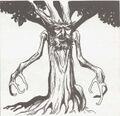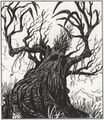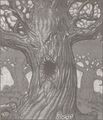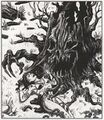Treant: Difference between revisions
1d4chan>Nubnuber No edit summary |
m (23 revisions imported) |
||
| (6 intermediate revisions by 5 users not shown) | |||
| Line 1: | Line 1: | ||
[[File:Treant 5e.png|thumb|right|300px]] | [[File:Treant 5e.png|thumb|right|300px]] | ||
{{Topquote|We come, we come with roll of drum: ta-runda runda runda rom!|The Ent's Marching Song,The Two Towers}} | |||
The '''Treant''' is the [[Dungeons & Dragons]] depiction of the iconic [[treeman]] monster. Stolen shamelessly from the depiction by [[J.R.R. Tolkien]], [[Gary Gygax]] changed the name from "ent" to "treant" in order to avoid legal disputes, much the same way that [[hobbits]] were turned into [[halflings]]. | The '''Treant''' is the [[Dungeons & Dragons]] depiction of the iconic [[treeman]] monster. Stolen shamelessly from the depiction by [[J.R.R. Tolkien]], [[Gary Gygax]] changed the name from "ent" to "treant" in order to avoid legal disputes, much the same way that [[hobbits]] were turned into [[halflings]]. | ||
| Line 10: | Line 12: | ||
The overlap between "treant" and "killer tree" is rather considerable, particularly in the days of [[Advanced Dungeons & Dragons]], with such creatures as Black Willows, Dark Trees, and Norans all called out as tree-monsters that are often mistaken for treants by the unwary or unwise. However, AD&D is also home to a number of a variant treants... most of which, strangely, are evil. | The overlap between "treant" and "killer tree" is rather considerable, particularly in the days of [[Advanced Dungeons & Dragons]], with such creatures as Black Willows, Dark Trees, and Norans all called out as tree-monsters that are often mistaken for treants by the unwary or unwise. However, AD&D is also home to a number of a variant treants... most of which, strangely, are evil. | ||
[[Dungeon Magazine]] #61 introduced | [[Dungeon Magazine]] #61 introduced the Greater Treant, which is basically a bigger, stronger, more magical version of the treant. It has never appeared in more official sourcebooks. | ||
==Dark Sun== | ==Dark Sun== | ||
| Line 19: | Line 21: | ||
Athasian treants are most commonly used to safeguard groves of trees of life, since conventional forests are pretty much unknown on Athas. Regardless, it bears mentioning that they are actually not that powerful by the standards of Athasian monsters - in fact, the water spirit is all around stronger and more dangerous, and the splatbooks even call this out! But, being rooted more firmly in the physical world makes Athasian treants far quicker to react to despoilers and [[Defiler (Dark Sun)|Defilers]] than a spirit, so the tradeoff is useful. | Athasian treants are most commonly used to safeguard groves of trees of life, since conventional forests are pretty much unknown on Athas. Regardless, it bears mentioning that they are actually not that powerful by the standards of Athasian monsters - in fact, the water spirit is all around stronger and more dangerous, and the splatbooks even call this out! But, being rooted more firmly in the physical world makes Athasian treants far quicker to react to despoilers and [[Defiler (Dark Sun)|Defilers]] than a spirit, so the tradeoff is useful. | ||
Compared to standard treants, Athasian treants are ''brutes'', doing a whopping 6d6 damage per strike from their branch-claws - for comparison's sake, an '''elder''' treant only does 4d6! They're capable of lifting up to 500 pounds, and can hurl a single boulder as a ranged attack each round, doing 4d6 damage on a hit. They're even more vulnerable to fire than regular treants, lacking the usual resistance to magical flames, but possess a natural affinity for water magic, which allows them to cast each of the following spells once per day: create water, purify food and drink, create food and water, lower water, reflecting pool, conjure elemental (water), part water, and transmute water to dust. Each of these is an innate ability of the Athasian treant and is cast without verbal, somatic, or material components at an initiative rating of 2. However, this spellcasting comes at the forfeiture of the standard treant ability | Compared to standard treants, Athasian treants are ''brutes'', doing a whopping 6d6 damage per strike from their branch-claws - for comparison's sake, an '''elder''' treant only does 4d6! They're capable of lifting up to 500 pounds, and can hurl a single boulder as a ranged attack each round, doing 4d6 damage on a hit. They're even more vulnerable to fire than regular treants, lacking the usual resistance to magical flames, but possess a natural affinity for water magic, which allows them to cast each of the following spells once per day: create water, purify food and drink, create food and water, lower water, reflecting pool, conjure elemental (water), part water, and transmute water to dust. Each of these is an innate ability of the Athasian treant and is cast without verbal, somatic, or material components at an initiative rating of 2. However, this spellcasting comes at the forfeiture of the standard treant ability to animate trees... which is no great loss, since Athas doesn't really HAVE that many trees. | ||
==Evil and Undead Treants== | ==Evil and Undead Treants== | ||
| Line 107: | Line 109: | ||
Evil treant blackroot.jpg | Evil treant blackroot.jpg | ||
Evil treant Shadow Rift.png | Evil treant Shadow Rift.png | ||
Evil treant CotN The Created.jpg | |||
Undead treant MC Ravenloft.jpg|Undead Treant | Undead treant MC Ravenloft.jpg|Undead Treant | ||
Undead treant DoD.jpg | Undead treant DoD.jpg | ||
Latest revision as of 10:32, 23 June 2023
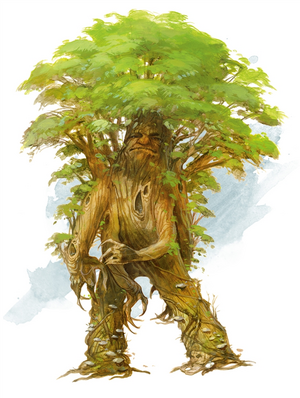
"We come, we come with roll of drum: ta-runda runda runda rom!"
- – The Ent's Marching Song,The Two Towers
The Treant is the Dungeons & Dragons depiction of the iconic treeman monster. Stolen shamelessly from the depiction by J.R.R. Tolkien, Gary Gygax changed the name from "ent" to "treant" in order to avoid legal disputes, much the same way that hobbits were turned into halflings.
Treants are massive trees with the ability to walk around and talk. They consider themselves the guardians and protectors of their non-mobile brethren, and thus defend the woods, forests and jungles from use by humanoid races.
Although usually typed as Plants, for obvious reasons, Treants have a tradition of being associated with fey creatures, mostly because those creatures are also typically portrayed as being close to nature and sworn to its defense. Treants were even a playable race in the Basic D&D supplement "Tall Tales of the Wee Folk", a splatbook dedicated to fey PC races.
The Family Tree[edit]
The overlap between "treant" and "killer tree" is rather considerable, particularly in the days of Advanced Dungeons & Dragons, with such creatures as Black Willows, Dark Trees, and Norans all called out as tree-monsters that are often mistaken for treants by the unwary or unwise. However, AD&D is also home to a number of a variant treants... most of which, strangely, are evil.
Dungeon Magazine #61 introduced the Greater Treant, which is basically a bigger, stronger, more magical version of the treant. It has never appeared in more official sourcebooks.
Dark Sun[edit]
The treants of Athas are highly unusual in that they are not natural creatures... well, "natural" by the standards of a D&D world. Instead, they are a kind of druidic golem, created when a druid successfully entreats a Spirit of the Land (water subtype) to enter a mystically prepared Tree of Life and bind with it, creating an enchanted sentinel set to protect a specific area. The ritual involves the spells Liveoak, Reincarnate and Tree of Life, and is not undertaken lightly; when the water spirit takes up residence in the tree of life, the water source originally inhabited by that spirit quickly dries up and disappears.
Still, the Athasian treant is an unflinching guardian; whilst it will seek to preserve its own life where possible, it will happily die to protect the wilderness, not least of which because its magical nature makes it immortal. Unless destroyed, an Athasian treant will live forever, and even if the treant itself is destroyed, the water spirit will simply be set free. Admittedly, it can't materialize again for a period of time equal to the time that it spent as a treant, but even so, it leaves the spirit completely unharmed. That said, the spirit and the treant do think of each other as separate entities; the treant retains no memories of its past existence as a water spirit, and will not give up its life just to resume its spirit form, whilst the spirit can remember what it experienced as a treant.
Athasian treants are most commonly used to safeguard groves of trees of life, since conventional forests are pretty much unknown on Athas. Regardless, it bears mentioning that they are actually not that powerful by the standards of Athasian monsters - in fact, the water spirit is all around stronger and more dangerous, and the splatbooks even call this out! But, being rooted more firmly in the physical world makes Athasian treants far quicker to react to despoilers and Defilers than a spirit, so the tradeoff is useful.
Compared to standard treants, Athasian treants are brutes, doing a whopping 6d6 damage per strike from their branch-claws - for comparison's sake, an elder treant only does 4d6! They're capable of lifting up to 500 pounds, and can hurl a single boulder as a ranged attack each round, doing 4d6 damage on a hit. They're even more vulnerable to fire than regular treants, lacking the usual resistance to magical flames, but possess a natural affinity for water magic, which allows them to cast each of the following spells once per day: create water, purify food and drink, create food and water, lower water, reflecting pool, conjure elemental (water), part water, and transmute water to dust. Each of these is an innate ability of the Athasian treant and is cast without verbal, somatic, or material components at an initiative rating of 2. However, this spellcasting comes at the forfeiture of the standard treant ability to animate trees... which is no great loss, since Athas doesn't really HAVE that many trees.
Evil and Undead Treants[edit]
One of the subtler themes of Gothic Horror can be summed up as "Nature is Evil". As a result, the treants of Ravenloft are uniformly malicious. Even a treant brought into the Demiplane of Dread from another world will soon find itself infected by the evil energies of the demiplane and corrupted into a murderous parody of its former self.
For the most part, evil treants are... well, treants but evil. They despise all that is good and innocent, and go to great lengths to torment and terrorize travelers in their domains. Whereas regular treants photosynthesize, evil treants are carnivores with a particular fondness for the flesh of sapient creatures - the more innocent and pure, the better. Such is their malice that most evil treants believe that meat is only digestible if consumed whilst a victim is still alive and screaming, and they will discard the corpses of those they accidentally torture to death before they can feed to rot rather than eat them. Forests where these creatures settle invariably become twisted, dark places, haunted by ghosts, magical predators and evil fey.
Legend has it that smearing one's body in sap taken from an evil treant will imbue the individual with supernatural durability, as if targeted by a Barkskin spell.
The most famous of all the evil treants in Ravenloft is Blackroot; once a sacred druidic oak tree in Tepest, he was ritually corrupted by the Sisters Mindefisk, the hag darklords of that domain, turning him into an abomination poised to take the realm for his own should the hags fall.
An even greater abomination than the standard evil treant is the undead treant; an evil treant that has refused to accept the end of its life and instead of deciding to go out in a final wild orgy of violence and death, has transformed itself into a kind of lichplant to continue its evil. Distinguishable by their lack of leaves and lusterless, almost brittle-looking bark, undead treants lose the ability to animate trees, but possess an instinctive command of druidic magic (typically having the equivalent of 2-6 levels in that class), can extrude blood-sucking roots to drain victims dry, and wield a number of the typical undead resiliences... however, they are also immune to the effects of sunlight, holy water, and the Turn Undead abilities of both clerics and paladins, as well as being immune to spells that specifically control either undead or plants.
Such is the malevolence of treants of Ravenloft that undead treants are not outcasts, but instead regarded as respected, even revered leaders amongst the circles of their still-living counterparts.
Alone amongst the treant variants listed on this page, Evil and Undead Treants made it into Dungeons & Dragons 3rd Edition.
Black Treant[edit]
Formally known as Lyrannikin, the so-called "Black Treants" of Greyhawk are not a species as such, but rather are treants who have been spiritually corrupted and turned to the path of evil. his happens in a variety of ways: by magical change; the heart of a treant becoming rotted by blight; or in the case of very ancient treants, a festering hatred of those who destroy old forests, so that the treant becomes consumed by a desire for revenge that becomes indiscriminate. They are a subject of deep pity amongst true treants, who usually try to capture them and cure them of their wickedness where possible. Their rage turns them into savage killers, sleeping only in short snatches of restless slumber driven to constantly move, hunt, and kill.
Roughly 30% of all lyrannikin suffer some horrible blight that corrupts and twists their woody flesh; the bark rots from their hides, their limbs decay and hang limply, and fungus wells up from within their cracks, crevices and recesses. Blighted lyrannikin suffer greatly from their decay; their lifespans are shortened (though, admittedly, it tends to be elderly treants who most vulnerable to the blights in the first place - the official ratios for blighted lyrannikin are given as 20% of younger, 30% of middle-aged, and 50% of elder), their blows weakened, and their ability to photosynthesize impeded, forcing them to substitute by bathing their roots in the blood of slaughtered creatures. The only dubious benefit is that blighted lyrannikin don't suffer the traditional treant vulnerability to fire, as their diseased timber is too soaked with wet rot and mold to catch light easily. Such blights aren't incurable, but the effort isn't easy.
It seems highly likely that the Scarlet Brotherhood has captured treants and is experimenting with the use of blights that will turn the treants to evil while not affecting their health or combat ability (no reductions to damage dice rolls). These specially-bred lyrannikin may well be being placed within the Menowood to attack the defenders of Sunndi who spy in the eastern margin of that wood; there have been several reports of young lyrannikin (an unusual occurrence) from that wood during the years of the Greyhawk Wars.
Treant PCs for BECMI[edit]
Ironically, the treant isn't the biggest or most powerful monster race-class in BECMI - that title actually goes to the sphinx. They have a 13 level racial class, starting at level -3 to represent the need to "mature" to be on par with a standard monster specimen of their race.
- Ability Score Minimum/Maximum: Strength 10/18, Dexterity 3/18, Constitution 8/18, Intelligence 3/18, Wisdom 6/18, Charisma 3/18
- Save as a Fighter with level equal to the greater of the treant's Hit Dice or Level.
- Usable Magic Items: Any Permitted to Fighters
- Natural Weapons: A treant can strike twice per round with its branch-limbs, doing 1d6 damage per strike at level -3, 1d8 at level -2, 1d10 at level -1, and finally 2d6 at level 0. These natural attacks benefit from high Strength, and a treant whose Hit Dice are high enough treats its natural weapons as if they were magic weapons, as per the rules for monsters.
- Natural Armor Class: A treant's natural armor class is AC 8 at level -3, AC 6 at level -2, AC 4 at level -1, and finally improves to AC 2 at level 0. Dexterity bonuses and penalties apply as normal.
- Bizarre Body Shape: Treants cannot wear armor of any sort, their tree-like bodies are simply impossible to create armor for. Additionally, some magic items may be unusable by treants due to being structured for humanoid use.
- Flammable: A treant struck by a fire-based attack takes +1 damage per damage die.
- Hardwood: An attack from a blunt weapon only inflicts (1+Str bonus+enchantment bonus) damage on a treant.
- Natural Camouflage: In a forest environment, a treant has a 50% chance to disguise itself as an ordinary tree.
- Animate Trees: From level 0, a treant can animate up to two trees that are within 60 feet to fight at its side. Animated trees have AC 2, HD 8, 2 Attacks doing 2d6 damage each, MV 30' (10'), Save as 8th level Fighters, and ML 12.
- Brew Potion: From 10th level, a treant can use ingredients harvested from the forest to brew analogues for common potions, just like a magic-user.
| (Level | Experience Points | Hit Dice |
|---|---|---|
| 0 | 0 | 8d8 |
| 1 | 48,000 | - |
| 2 | 145,000 | 9d8 |
| 3 | 340,000 | - |
| 4 | 640,000 | 10d8 |
| 5 | 940,000 | - |
| 6 | 1,240,000 | 11d8 |
| 7 | 1,540,000 | - |
| 8 | 1,840,000 | 12d8 |
| 9 | 2,140,000 | - |
| 10 | 2,440,000 | 12d8+3 |
Each subsequent level costs 300,000 EXP and grants +3 hit points.
Gallery[edit]
-
1e
-
PC1
-
AD&D Monster Card
-
2e
-
Monstrous Compendium: Vol. 1
-
3e
-
4e
-
5e
-
Pathfinder
-
Evil Treant
-
-
-
-
Undead Treant
-
| Dungeons & Dragons 1st Edition Races | |
|---|---|
| Basic Set | Dwarf • Elf • Hobbit • Human |
| Creature Crucible 1 | Brownie • Centaur • Dryad • Faun • Hsiao • Leprechaun • Pixie • Pooka • Redcap • Sidhe • Sprite • Treant • Wood Imp • Wooddrake |
| Creature Crucible 2 | Faenare • Gnome • Gremlin • Harpy • Nagpa • Pegataur • Sphinx • Tabi |
| Creature Crucible 3 | Kna • Kopru • Merrow • Nixie • Sea Giant • Shark-kin • Triton |
| Dragon Magazine | Cayma • Gatorman • Lupin • N'djatwa • Phanaton • Rakasta • Shazak • Wallara |
| Hollow World | Beastman • Brute-Man • Hutaakan • Krugel Orc • Kubitt • Malpheggi Lizard Man |
| Known World | Bugbear • Goblin • Gnoll • Hobgoblin • Kobold • Ogre • Troll |



